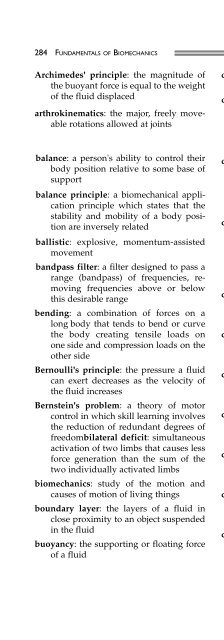Fundamentals of Biomechanics
Fundamentals of Biomechanics
Fundamentals of Biomechanics
Create successful ePaper yourself
Turn your PDF publications into a flip-book with our unique Google optimized e-Paper software.
284 FUNDAMENTALS OF BIOMECHANICS<br />
Archimedes' principle: the magnitude <strong>of</strong><br />
the buoyant force is equal to the weight<br />
<strong>of</strong> the fluid displaced<br />
arthrokinematics: the major, freely moveable<br />
rotations allowed at joints<br />
balance: a person's ability to control their<br />
body position relative to some base <strong>of</strong><br />
support<br />
balance principle: a biomechanical application<br />
principle which states that the<br />
stability and mobility <strong>of</strong> a body position<br />
are inversely related<br />
ballistic: explosive, momentum-assisted<br />
movement<br />
bandpass filter: a filter designed to pass a<br />
range (bandpass) <strong>of</strong> frequencies, removing<br />
frequencies above or below<br />
this desirable range<br />
bending: a combination <strong>of</strong> forces on a<br />
long body that tends to bend or curve<br />
the body creating tensile loads on<br />
one side and compression loads on the<br />
other side<br />
Bernoulli's principle: the pressure a fluid<br />
can exert decreases as the velocity <strong>of</strong><br />
the fluid increases<br />
Bernstein's problem: a theory <strong>of</strong> motor<br />
control in which skill learning involves<br />
the reduction <strong>of</strong> redundant degrees <strong>of</strong><br />
freedombilateral deficit: simultaneous<br />
activation <strong>of</strong> two limbs that causes less<br />
force generation than the sum <strong>of</strong> the<br />
two individually activated limbs<br />
biomechanics: study <strong>of</strong> the motion and<br />
causes <strong>of</strong> motion <strong>of</strong> living things<br />
boundary layer: the layers <strong>of</strong> a fluid in<br />
close proximity to an object suspended<br />
in the fluid<br />
buoyancy: the supporting or floating force<br />
<strong>of</strong> a fluid<br />
center <strong>of</strong> buoyancy: the point at which the<br />
buoyant force acts<br />
center <strong>of</strong> mass/gravity: the point that represents<br />
the total weight/mass distribution<br />
<strong>of</strong> a body; the mass centroid is the<br />
point where the mass <strong>of</strong> an object is balanced<br />
in all directions<br />
center <strong>of</strong> percussion: a point on a striking<br />
object where impact with another object<br />
results in no reaction force at an<br />
associated point on the grip (see<br />
“sweet spot”)<br />
center <strong>of</strong> pressure: the location <strong>of</strong> the vertical<br />
ground reaction force vector; the<br />
center <strong>of</strong> pressure measured by a force<br />
platform represents the net forces in<br />
support and the COP may reside in regions<br />
<strong>of</strong> low local pressure<br />
coactivation: simultaneous activation <strong>of</strong> agonist<br />
and antagonist muscles (co-contraction)<br />
coefficient <strong>of</strong> drag: a measure <strong>of</strong> the relative<br />
fluid resistance between an object<br />
and a fluid<br />
coefficient <strong>of</strong> friction: a measure <strong>of</strong> the<br />
resistance to sliding between the surfaces<br />
<strong>of</strong> two materials<br />
coefficient <strong>of</strong> lift: a measure <strong>of</strong> the lift force<br />
that can be created between an object<br />
and a fluid<br />
coefficient <strong>of</strong> restitution: a measure <strong>of</strong> the<br />
relative elasticity <strong>of</strong> the collision between<br />
two objects<br />
common mode rejection: a measure <strong>of</strong> the<br />
quality <strong>of</strong> a differential amplifier in rejecting<br />
common signals (noise)<br />
compression: a squeezing mechanical loading<br />
created by forces in opposite directions<br />
acting along a longitudinal axis






